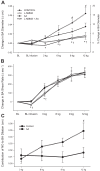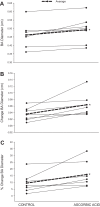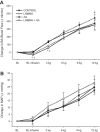Ascorbic acid improves brachial artery vasodilation during progressive handgrip exercise in the elderly through a nitric oxide-mediated mechanism
- PMID: 26801312
- PMCID: PMC4867342
- DOI: 10.1152/ajpheart.00817.2015
Ascorbic acid improves brachial artery vasodilation during progressive handgrip exercise in the elderly through a nitric oxide-mediated mechanism
Erratum in
-
Errata for vol. 313, p.Am J Physiol Heart Circ Physiol. 2017 Aug 1;313(2):H457. doi: 10.1152/ajpheart.00817.2015-corr.2017. Am J Physiol Heart Circ Physiol. 2017. PMID: 28801481 Free PMC article. No abstract available.
Abstract
The proposed mechanistic link between the age-related attenuation in vascular function and free radicals is an attractive hypothesis; however, direct evidence of free radical attenuation and a concomitant improvement in vascular function in the elderly is lacking. Therefore, this study sought to test the hypothesis that ascorbic acid (AA), administered intra-arterially during progressive handgrip exercise, improves brachial artery (BA) vasodilation in a nitric oxide (NO)-dependent manner, by mitigating free radical production. BA vasodilation (Doppler ultrasound) and free radical outflow [electron paramagnetic resonance (EPR) spectroscopy] were measured in seven healthy older adults (69 ± 2 yr) during handgrip exercise at 3, 6, 9, and 12 kg (∼13-52% of maximal voluntary contraction) during the control condition and nitric oxide synthase (NOS) inhibition via N(G)-monomethyl-L-arginine (L-NMMA), AA, and coinfusion of l-NMMA + AA. Baseline BA diameter was not altered by any of the treatments, while L-NMMA and L-NMMA + AA diminished baseline BA blood flow and shear rate. AA improved BA dilation compared with control at 9 kg (control: 6.5 ± 2.2%, AA: 10.9 ± 2.5%, P = 0.01) and 12 kg (control: 9.5 ± 2.7%, AA: 15.9 ± 3.7%, P < 0.01). NOS inhibition blunted BA vasodilation compared with control and when combined with AA eliminated the AA-induced improvement in BA vasodilation. Free radical outflow increased with exercise intensity but, interestingly, was not attenuated by AA. Collectively, these results indicate that AA improves BA vasodilation in the elderly during handgrip exercise through an NO-dependent mechanism; however, this improvement appears not to be the direct consequence of attenuated free radical outflow from the forearm.
Keywords: aging; endothelium; l-NMMA; vascular function.
Figures







Similar articles
-
Contribution of nitric oxide to brachial artery vasodilation during progressive handgrip exercise in the elderly.Am J Physiol Regul Integr Comp Physiol. 2013 Oct 15;305(8):R893-9. doi: 10.1152/ajpregu.00311.2013. Epub 2013 Aug 15. Am J Physiol Regul Integr Comp Physiol. 2013. PMID: 23948773 Free PMC article.
-
Nitric oxide, but not vasodilating prostaglandins, contributes to the improvement of exercise hyperemia via ascorbic acid in healthy older adults.Am J Physiol Heart Circ Physiol. 2010 Nov;299(5):H1633-41. doi: 10.1152/ajpheart.00614.2010. Epub 2010 Sep 3. Am J Physiol Heart Circ Physiol. 2010. PMID: 20817831 Free PMC article. Clinical Trial.
-
Progressive handgrip exercise: evidence of nitric oxide-dependent vasodilation and blood flow regulation in humans.Am J Physiol Heart Circ Physiol. 2011 Mar;300(3):H1101-7. doi: 10.1152/ajpheart.01115.2010. Epub 2011 Jan 7. Am J Physiol Heart Circ Physiol. 2011. PMID: 21217074 Free PMC article.
-
Prostaglandins do not contribute to the nitric oxide-mediated compensatory vasodilation in hypoperfused exercising muscle.Am J Physiol Heart Circ Physiol. 2011 Jul;301(1):H261-8. doi: 10.1152/ajpheart.00222.2011. Epub 2011 May 2. Am J Physiol Heart Circ Physiol. 2011. PMID: 21536852 Free PMC article.
-
Endothelium-dependent NO-mediated vasodilation in humans is attenuated by peripheral alpa1-adrenoceptor activation.Vasc Health Risk Manag. 2005;1(3):251-6. Vasc Health Risk Manag. 2005. PMID: 17319111 Free PMC article. Clinical Trial.
Cited by
-
Flow-mediated dilation stimulated by sustained increases in shear stress: a useful tool for assessing endothelial function in humans?Am J Physiol Heart Circ Physiol. 2018 Mar 1;314(3):H508-H520. doi: 10.1152/ajpheart.00534.2017. Epub 2017 Nov 22. Am J Physiol Heart Circ Physiol. 2018. PMID: 29167121 Free PMC article. Review.
-
Elevated arterial shear rate increases indexes of endothelial cell autophagy and nitric oxide synthase activation in humans.Am J Physiol Heart Circ Physiol. 2019 Jan 1;316(1):H106-H112. doi: 10.1152/ajpheart.00561.2018. Epub 2018 Nov 9. Am J Physiol Heart Circ Physiol. 2019. PMID: 30412436 Free PMC article.
-
The role of T-type calcium channels in elderly human vascular function: A pilot randomized controlled trial.Exp Physiol. 2024 May;109(5):779-790. doi: 10.1113/EP091645. Epub 2024 Mar 6. Exp Physiol. 2024. PMID: 38445814 Free PMC article. Clinical Trial.
-
Vitamin C Acutely Affects Brain Perfusion and Mastication-Induced Perfusion Asymmetry in the Principal Trigeminal Nucleus.Front Syst Neurosci. 2021 Feb 26;15:641121. doi: 10.3389/fnsys.2021.641121. eCollection 2021. Front Syst Neurosci. 2021. PMID: 33716681 Free PMC article.
-
The impact of a superfood chocolate beverage on indices of peripheral vascular function.Physiol Rep. 2025 Jul;13(13):e70448. doi: 10.14814/phy2.70448. Physiol Rep. 2025. PMID: 40611568 Free PMC article.
References
-
- Anderson TJ, Uehata A, Gerhard MD, Meredith IT, Knab S, Delagrange D, Lieberman EH, Ganz P, Creager MA, Yeung AC. Close relation of endothelial function in the human coronary and peripheral circulations. J Am Coll Cardiol 26: 1235–1241, 1995. - PubMed
-
- Ashton T, Young IS, Peters JR, Jones E, Jackson SK, Davies B, Rowlands CC. Electron spin resonance spectroscopy, exercise, and oxidative stress: an ascorbic acid intervention study. J Appl Physiol 87: 2032–2036, 1999. - PubMed
-
- Bailey DM. Radical dioxygen: from gas to (unpaired!) electrons. Adv Exp Med Biol 543: 201–221, 2003. - PubMed
-
- Bailey DM, Davies B, Young IS, Jackson MJ, Davison GW, Isaacson R, Richardson RS. EPR spectroscopic detection of free radical outflow from an isolated muscle bed in exercising humans. J Appl Physiol 94: 1714–1718, 2003. - PubMed
Publication types
MeSH terms
Substances
Grants and funding
LinkOut - more resources
Full Text Sources
Other Literature Sources
Medical

